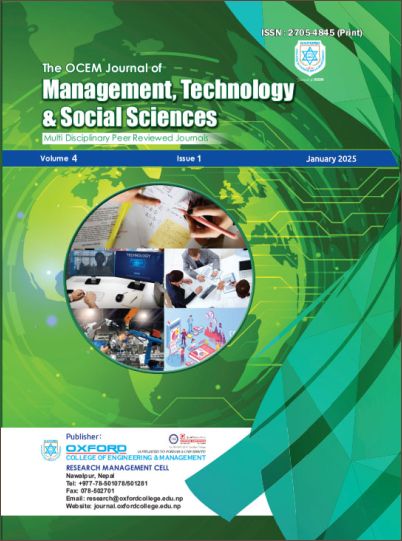Use of Waste Plastic as a Replacement for Bitumen in Road Construction
DOI:
https://doi.org/10.3126/ocemjmtss.v4i1.74752Keywords:
Plastic, low density plastic, Plastic-Coated Aggregate, Plastic Modified BitumenAbstract
Plastic waste pollution has become a global environmental crisis, particularly due to non recyclable and low-density plastics, which contribute significantly to landfill accumulation and environmental harm. This research investigates the use of plastic waste in road con-struction as a sustainable alternative to traditional materials like bitumen and aggregates. By integrating plastic waste into road infrastructure, this study explores methods such as plasticcoated aggregates, plastic-modified bitumen, and fully plastic based roads. These approaches not only enhance the mechanical properties of roads but also help reduce the environmental footprint of construction activities.
Plastic-coated aggregates and plastic-modified bitumen improve road durability, weather resistance, and load-bearing capacity, making them more suitable for high-traffic areas and harsh climates. Furthermore, plastic roads show lower maintenance requirements, resulting in long-term cost savings. From an environmental perspective, using plastic waste in road construction helps reduce plastic pollution, curtailing the burden on landfills, and decreas-ing the energy consumption and carbon emissions associated with conventional road-building materials.
This research underscores the potential of plastic waste integration as a dual solution: ad-dressing the plastic waste crisis and promoting sustainable infrastructure. The findings highlight the eco-friendly and cost-effective nature of using plastic waste in road construc-tion, presenting it as a promising approach for the future of sustainable infrastructure de-velopment. Using waste plastic as a replacement for bitumen in road construction reduces environmental pollution, enhances road durability, reduces construction costs, minimizes plastic waste, and lowers environmental pollution. However, potential drawbacks include microplastic release, health concerns during production, and the complex waste segregation requirements.
Downloads
Downloads
Published
How to Cite
Issue
Section
License
Copyright (c) 2025 Authors and OCEM Journal of Management, Technology & Social Sciences

This work is licensed under a Creative Commons Attribution-NonCommercial 4.0 International License.
This license enables reusers to distribute, remix, adapt, and build upon the material in any medium or format for noncommercial purposes only, and only so long as attribution is given to the creator.




